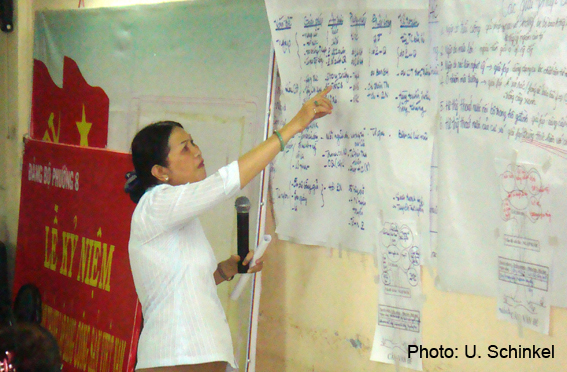WP 8 - Livable City - Urban Regeneration and Community-Based Adaptation
Responsible Contact
Ulrike Schinkel (BTU Cottbus, Department of Urban Planning and Spatial Design)
Main Objectives
Renewal and adaptation strategies for existing housing structures:
- Cooperation with existing urban development projects
- To identify areas and needs for redevelopment
- Redevelopment of the central area of HCMC
Urban Regeneration
Within the research consortium, WP8 ‘Urban Regeneration and Community-Based Adaptation’ mainly focused on the development of adaptation strategies in existing, underprivileged neighbourhoods that are frequently affected by flooding and thermal stress. In contrast to other WPs, main focus was laid on low-tech and low-cost measures as well as on collective action to respond to climate change.
Community-Based Adaptation (CBA)
CBA as a bottom-up approach
CBA is an approach designed to enable communities to take joint action to respond to the impacts of climate change and to build resilient livelihoods. CBA is a community-led approach that is based on locally available resources as well as on skills and capacities of community members. While communities are core actors at the local level, external actors support CBA as advisors and facilitators.
However, even though communities develop and implement effective local level adaptation strategies for the nonce, CBA projects cannot be successful in isolation. CBA activities are limited in scale and scope; some climate change impacts and the majority of underlying drivers of local level vulnerability cannot be addressed by communities themselves, but require attention from the private sector, from higher government levels and from policy makers. Thus, as a bottom-up approach, CBA can only complement top-down approaches to climate change adaptation rather than substitute them.
Actors involved in CBA
Communities and their adaptation efforts significantly benefit from the involvement of external actors such as researchers and practitioners, civil society organizations and local as well as national government agencies that partner with communities and other actors involved.
Researchers and scientists provide scientific input such as long-term predictions for future climate trends that support the design of adaptation measures and strategies. Practitioners, e.g. community architects or builders, provide technical support during the planning and implementation of physical measures and technical solutions. Eventually, members of this expert group help to minimize the risk of mal-adaptation and of developing resource-intensive response strategies that cannot be sustained in the long-term.
Another main important group of actors are civil society organizations that directly support and guide community processes, e.g.as community mobilizers and workshop moderators, as facilitators of community action planning activities and during plan implementation, monitoring and evaluation activities. Civil society organizations may also mediate between all stakeholder groups involved and promote the incorporation of local adaptive capacity into policies and large-scale adaptation plans and projects.
The third group of actors important for CBA are local governments and related planning departments that should provide information on planned future developments affecting communities and their living environments. Besides, planning departments should work on the integration of local adaptive capacity and locally generated information into development plans, projects and policies.
Successful CBA also depends on an enabling policy environment that fosters bottom-up approaches to climate change adaptation. CBA activities need to be linked to top-down planning procedures, project and policy development; local level CBA activities require incentives, guidance and institutional support.

